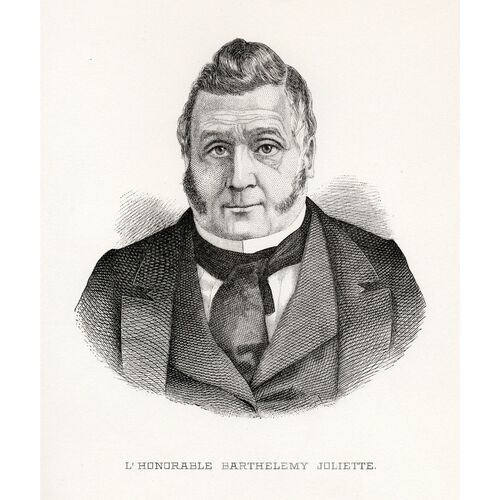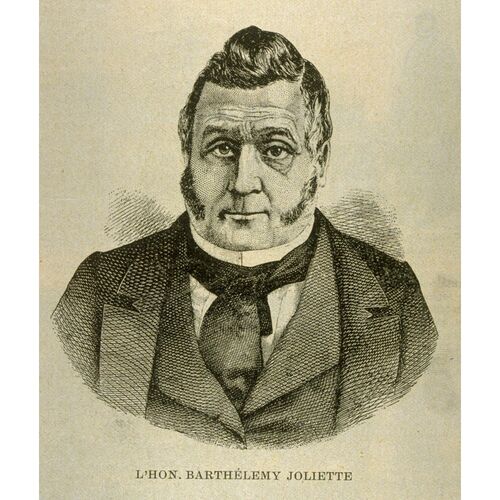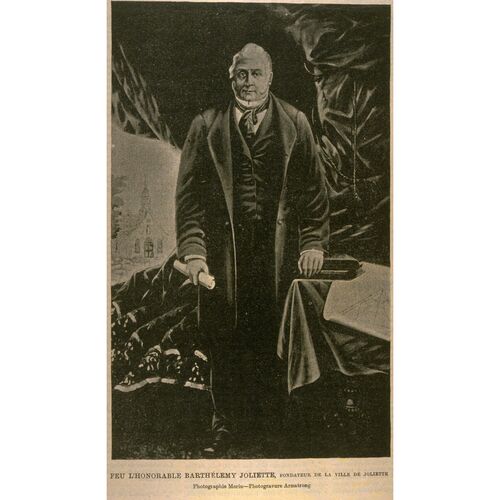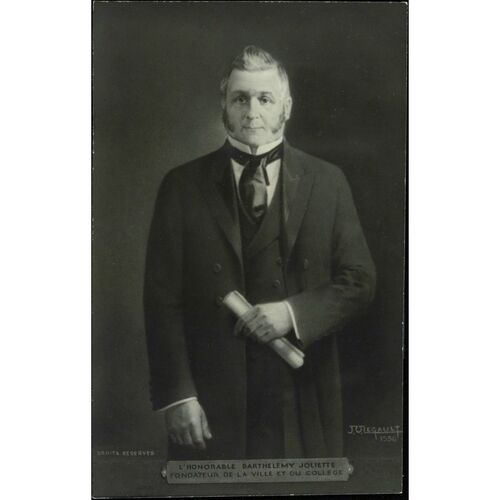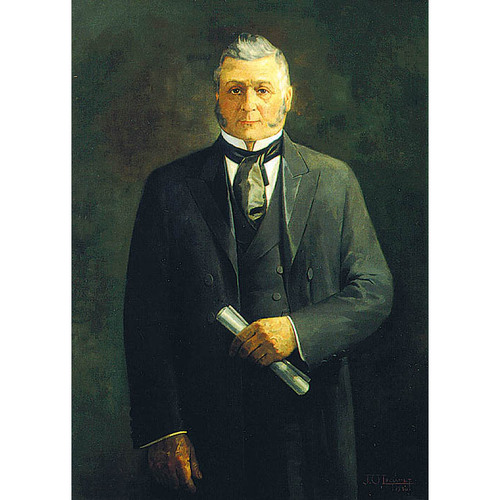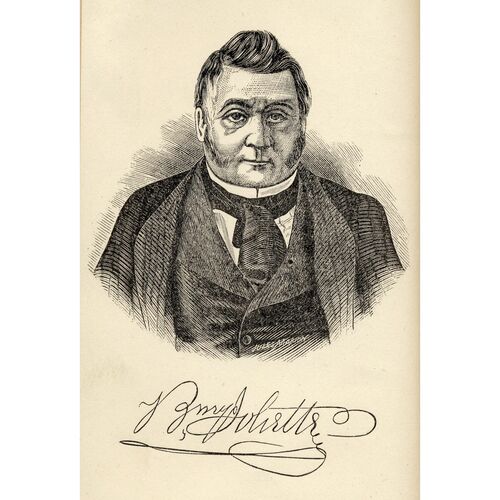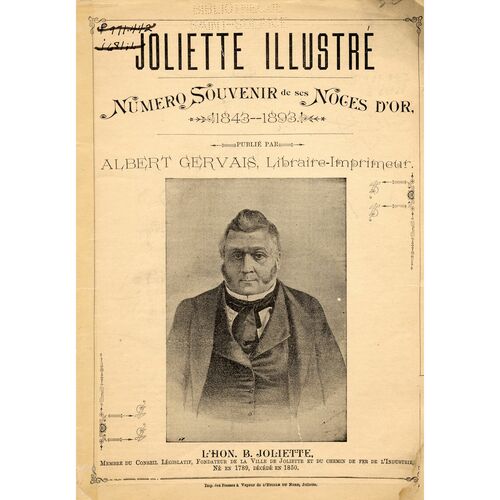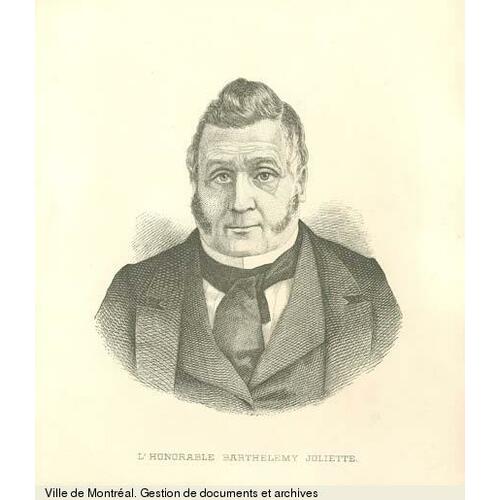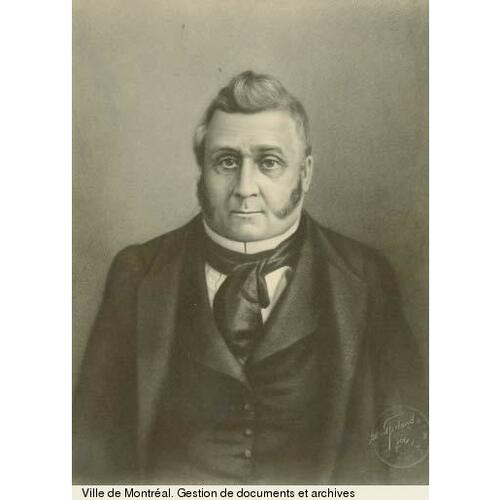JOLIETTE, BARTHÉLEMY, militia officer, notary, politician, seigneur, businessman, and jp; b. 9 Sept. 1789 in Saint-Thomas parish (Montmagny), Que., son of Antoine Jolliet (Joliette), a notary, and Catherine Faribault; m. 27 Sept. 1813 Charlotte Lanaudière (Tarieu Taillant de Lanaudière) at Lavaltrie, Lower Canada, and they had one child, Charles Barthélemy, who died in 1820 at five years of age; d. 21 June 1850 in Industrie (Joliette), Lower Canada.
Barthélemy Joliette belonged through his father to the family of explorer Louis Jolliet* and through his mother to the Faribaults of L’Assomption. His father died a few years after Barthélemy’s birth, in 1791. His mother then returned to live in the Montreal region, and on 23 Sept. 1799 she married François Pétrimoulx. Young Barthélemy attended the village school in L’Assomption and in 1804 was sent to learn the profession of notary in the office of his maternal uncle Joseph-Édouard Faribault*. He could not have had a better teacher. Faribault was not only a prosperous and respected notary but the prototype of the notary-businessman. In fact, he managed properties for various people and looked after several sawmills and flour-mills in the region. On 3 Oct. 1810 Joliette received his notary’s commission: he could then stand on his own feet.
Joliette’s career can be divided into three major periods. During the first, from 1810 to 1822, he practised his profession and emerged as one of the local élite. The second period, which extended from 1822 to 1832, was marked by his activities as a seigneur and entrepreneur. The last, from 1832 to 1850, corresponded to his activities as a businessman and politician.
Joliette’s later success may overshadow his notarial career. He was in practice only from 1810 to 1824, but during his busy years he drew up more than 300 deeds annually, and, after 1815, often more than 350. Consequently he could count on a large and regular income. In 1812 he was able to buy a well-situated house in the small market town of L’Assomption and have it altered to suit his needs. At that time L’Assomption served a rapidly growing rural area as a centre for services. Furthermore, Joliette had an excellent reputation and people came from the neighbouring parishes to consult him. According to his first biographer, Joseph Bonin, he was recognized for his skill in sorting out complicated matters.
Joliette made a good match in 1813 when he married Charlotte Lanaudière. She was the daughter of Charles-Gaspard Tarieu Taillant de Lanaudière and Suzanne-Antoinette Margane de Lavaltrie, and brought as her dowry an undivided quarter of the seigneury of Lavaltrie as well as other properties of lesser importance. For the moment these holdings were not any use to the young couple because the donor, Charlotte’s maternal grandmother, had reserved the usufruct for herself until her death, which occurred in 1815. After that the Joliettes let Charlotte’s mother have their share of the income from the seigneury.
During these years Joliette gradually became a leading member of the community. He had been a militia officer since 1808, was posted as a captain to the Lavaltrie battalion of militia in 1812, and took part in the War of 1812. He became major in the battalion in 1814. He also ventured into politics, but his earliest attempts were unsuccessful. He ran in Leinster in 1814 but was beaten by Jacques Trullier*, dit Lacombe. He contested the outcome successfully, but lost decisively in the new election that was ordered. In 1820 he was once more a candidate in the riding and was finally elected, but the session was prorogued a short time later and he did not run in the elections that followed. In another connection, Joliette was chosen as commissioner for rebuilding the parish church in 1819. Thus by the beginning of 1820s he was clearly well established in the region’s élite; connected with distinguished families, engaged personally in economic development as either an owner or an administrator, he received certain posts and was prominent professionally.
The year 1822 was an important one in Joliette’s career, for his mother-in-law’s death freed up the Tarieu Taillant de Lanaudière estate. The children, Pierre-Paul, Charlotte, and Marie-Antoinette, became its owners. The eldest, Pierre-Paul, was entitled to 50 per cent of the rights, and the two sisters to 25 per cent each. Charlotte, who had already received her share as a dowry, waived her rights. The assets consisted mainly of the seigneury of Lavaltrie and the first concessions of Kildare Township, which bordered on it. To that were added a few rights to the seigneuries of Petit-Longueuil and Saint-Vallier. Joliette soon gave up his notarial practice in favour of a new career as a seigneur and entrepreneur. It was a completely new orientation for him.
Joliette was, of course, only indirectly a seigneur, since in reality his wife held title to the property. He meant nevertheless to be treated as such, and it is his name that appears on the various leases that the seigneurs of Lavaltrie granted. On the whole, Joliette had no difficulty obtaining recognition of himself as a seigneur, except at the church; he demanded seigneurial privileges there, but they were refused him by Bishop Jean-Jacques Lartigue in 1826. He dominated the coseigneurs, however. Even though the principal heir, Pierre-Paul Tarieu Taillant de Lanaudière, held half the rights on the seigneury, he seems not to have been interested in the day-by-day running of affairs, which he gladly left to his brother-in-law. The other Lanaudière sister was married to a doctor, Peter Charles Loedel, who participated in Joliette’s undertakings. Joliette had in his favour his background as a notary and the experience he had gained with his uncle, who had administered the seigneury of Lavaltrie from 1812 to 1822. He held another winning card. Having let his mother-in-law receive all the income from the seigneury after 1815, he had her sign an acknowledgement of debt in 1820. Thus when his wife refused the legacy, they became the estate’s creditors. Joliette’s fundamental role in affairs was confirmed by a private contract signed in 1825.
From the outset the seigneurs proceeded to develop Lavaltrie in three important ways: tightening up management, exploiting the forest resources, and creating the village of Industrie. In 1822, 370 of the censitaires were in debt to the seigneurs for about 80,000 livres; within three years virtually the entire sum had been paid back, and it seems clear that arrears were less tolerated. More attention was being paid to management. The censitaires were urged to pay their debts, and some did so by supplying labour or even sawlogs for the mill. As for the obstinate, 19 of them had to face lawsuits. The new seigneurs also kept a jealous eye on their right of banality: for example, in 1825 they required the parish priest, Joseph-Marie Bellenger*, to remind his flock of their obligation to take their wheat to the seigneurial mill. The priest informed the bishop fully of the harshness of Joliette’s management.
The project that really gave new impetus to the seigneury, however, was lumbering. Lavaltrie still had a few pieces of land that had not been distributed for settlement, but, more important, not all its territory was occupied, some still being in standing timber. Consequently a new seigneurial domain was formed by taking back five properties along the Rivière L’Assomption. They had a remarkable pine forest that was logged for the Quebec market. Joliette probably wanted to maximize his profits by sawing the wood into planks of standard dimensions for export to Great Britain instead of selling it as squared timber. To do that, he had to put up a sawmill capable of handling the wood and to ensure that he had adequate means for transporting his planks to Quebec. In December 1822 contracts. were signed for the construction of an imposing three-storey stone mill measuring 115 feet by 50. This building was intended to be a multi-purpose one: it was also to serve as a flour-mill and it contained a shingle-mill and carding and fulling machines. The first logs went through in the spring of 1824. As for transportation, the planks were moved on sleighs to bypass the rapids on the river and then were taken on rafts as far as the St Lawrence, where they were loaded on ships for Quebec.
Once the new domain had been cleared, in the autumn of 1826, the lumbering operation came to belong solely to Joliette and Peter Charles Loedel; Pierre-Paul Tarieu Taillant de Lanaudière seems to have been excluded. The partners, seeking a regular supply of wood, reached agreements with the neighbouring seigneurs to log their lands. At that time the seigneuries on the back concession such as Ramezay and Ailleboust, which adjoined Lavaltrie, were just beginning to be settled. The first time the planks were sold at Quebec, Joliette went down there expressly for the purpose; later he proceeded through contracts that included advances on consignment, as in 1827 when he did business with William Price*.
Development of a village constituted the third component of the profit-making plan. The building of a large mill was the starting point for the population centre to be created. The advantages were numerous. The village-type lots offered an opportunity for the seigneurs to make additional profits, particularly through the workings of the lods et ventes. In addition, by attracting to the site the surplus population from neighbouring parishes they could be assured of a sufficiently large reservoir of labour, which could in turn attract or facilitate other investments. The village of Industrie offered people of the region job possibilities that did not exist elsewhere.
The first building sites were granted in November 1824, and in 1826 Joliette and Loedel decided to put up residences, imposing for the time and place, that they called their manor-houses. The little village gradually expanded under the stimulus of various new services. For example, around 1825 a former clerk in Joliette’s office, Jean-Olivier Leblanc, came to set up as a notary at Industrie; from then on it was no longer necessary to go to Berthier-en-Haut (Berthierville) or L’Assomption to have deeds drawn up, and the residents of surrounding parishes acquired the habit of coming to the village. In 1826 Joliette was appointed justice of the peace and could settle small causes in his region. He was promoted lieutenant-colonel of the 2nd Battalion of Warwick militia in 1827. Three years later he was also elected to the House of Assembly for L’Assomption, a treasured proof of the esteem in which he was held. He retained his seat until 1832, when he was called to the Legislative Council. The village, however, was not successful in obtaining a church, for the bishop would not allow it. Yet a recognition of suzerainty and census in 1829 shows that Industrie already counted 35 houses and 29 other buildings of various sorts, whereas the village of Saint-Paul, about a mile away, had only a score. Industrie was demonstrating its success, to which an article published in Michel Bibaud*’s La Bibliothèque canadienne in 1829 testified. This progress was not achieved without a certain rivalry, as the bishop’s resistance shows, for the village’s growth took place to the detriment of Saint-Paul and also of the concessions opened up in the other seigneuries.
The year 1832 marked a new stage in Joliette’s career. On top of his appointment to the Legislative Council, an effect of which was to establish his prestige, came the death of his brother-in-law Pierre-Paul, which strengthened his authority. As guardian of the latter’s children, he was thenceforth in control of 75 per cent of the seigneurial rights. He would now endeavour to consolidate his enterprises.
Management of the seigneury seemed to be going smoothly, and Joliette’s only new initiative was to have the land roll redone in 1833. Wood monopolized his energies. He increased production capacity around 1837 by having a second sawmill built not far from the first; that year he interested a newcomer, merchant Edward Scallon*, in his undertakings. The search for raw material was forcing his employees farther and farther up the rivers. In the 1840s, for example, he received permission to cut timber along the Rivière L’Assomption over a distance of 26 miles from the mouth and for 10 miles on each side of the river and its tributaries. He conducted his logging operations in two ways, by organizing the camps himself or subcontracting. In 1835, for example, he contracted with a farmer in Kildare Township for delivery of 5,000 pine logs; a few months later the farmer shared out the cutting to other farmers, keeping a substantial quantity of logs for his own camp.
The selling of planks was still done at Quebec, and, from 1839 to 1846, through the agency of Ryan Brothers and Company. The Ryans advanced Joliette money and undertook in turn to sell his production for a five per cent commission. This system, advantageous for an entrepreneur who lacked capital, could not, however, withstand a series of price drops on the Quebec market, because the supplier then became indebted to the merchant and piled up deficits. And indeed, in the late 1840s the lumber trade was encountering difficulties.
In order to stimulate the village’s growth, Joliette tried new investments. In 1839 he had a distillery built, rapidly making ownership of it over to his partner Scallon. He is also supposed to have had other plans, such as one for a glass factory, but his main achievement, at the end of the 1840s, was unquestionably his railway. In the hope of solving once and for all the problem of transportation for his lumber and also of giving Industrie direct access to the St Lawrence, Joliette envisioned a line 12 miles or so long that would link his village with that of Lanoraie. In February 1847 Joliette, Loedel, Scallon, and Gaspard Tarieu de Lanaudière (Joliette’s nephew) applied for incorporation. Late in the year the shares in the new firm, named the Compagnie du Chemin à Rails du Saint-Laurent et du Village d’Industrie, were offered for sale in the region. Work began on the embankments in 1848 and the line, finished in 1850, was inaugurated with great ceremony on 1 May. The rolling-stock, which was second-hand, had been bought from the Champlain and St Lawrence Railroad.
Along with these contributions to the economic development of the village Joliette succeeded in realizing two other projects, one for a church and the other for a college. In 1841 the bishop of Montreal, Ignace Bourget*, finally gave permission to build a chapel. Joliette was not satisfied; in 1842 he began to construct a church, largely at his own expense, and the following year he obtained canonical erection of a new parish. His village now provided the essential services. Three years later Joliette had a college built that was handed over in 1847 to the care of the Clerics of St Viator, who had recently arrived from France [see Étienne Champagneur*].
Joliette’s interest in education was not new. He had already concerned himself with the primary schools at L’Assomption in 1825 and 1831. He wanted the Collège de Joliette, however, to offer a training different from that given in the classical colleges, which he criticized for teaching only Latin and not giving young people an adequate education. In fact, he was not keen on the teaching of Latin, favouring English and mathematics. Clearly he wanted his college to give courses oriented towards the business professions, and he appears to have convinced the Clerics of St Viator of the soundness of his ideas.
These investments had important repercussions on the development of Industrie, which began to look more and more like a real urban centre. While recognizing the merits of its patron, the parish priest, Antoine Manseau*, was not deceived about the general purpose of these investments by Joliette, who was determined to retain ownership of the church and college. A man of dictatorial nature, he conducted himself as the master of his domain and was bent on retaining control of all his people.
Joliette’s political career was uneventful. Having served as a legislative councillor since 1832, he became a member of the Special Council following suspension of the constitution in February 1838. At the time of the rebellion in 1837 he remained a firm loyalist, refusing to support Louis-Joseph Papineau*’s party and actively opposing any attempt at agitation in his region. In December 1837 he presided over an assembly of the magistrates and militia officers of the region that reaffirmed its loyalty to the government. Later he acted directly as justice of the peace and signed at least one arrest warrant, in January 1838. Joliette seems to have been absent from the Special Council for the vote on union of Upper and Lower Canada in 1839. After the union was proclaimed, he was appointed to the new legislative council on 9 June 1841. That year he supported an amendment expressing doubts about the legality of the union. Apparently he did his work seriously, piloting petitions or carefully preparing addresses for the council as a whole.
In 1850 Joliette, who was ill, gave in to the chiding of Father Manseau and the Clerics of St Viator: he turned over ownership of the church and college with the adjoining lands to the parish priest and the Clerics respectively. Before he died he had the chance to see his railroad, which he called his last work, in service.
Barthélemy Joliette had wielded enormous influence which extended well beyond the village he had founded. Testimonies to his renown are not lacking. For his Rivardville in the novel Jean Rivard, économiste (1864), Antoine Gérin-Lajoie* took his inspiration especially from Joliette’s creation of Industrie. As early as 1874 a biography of Joliette was published. During the first half of the 19th century he had indeed been an important player in the growth and development of the Lower Canadian economy. He had known how to seize the possibilities offered by the seigneury, the censitaires, and the economic situation in order to carry out his plans. For any discussion of urbanization, industrialization, the transition from feudalism to capitalism, or the evolution of the seigneurial régime, his story is interesting and exemplary.
Barthélemy Joliette’s minute-book for the period 1810–48 is at ANQ-M, CN5-24. It contains 3,030 instruments, 2,997 of which date from before October 1824. The most important archival sources for studying his career are the collections of the Soc. hist. de Joliette (Joliette, Qué.) and the minute-book of notary J.-O. Leblanc at ANQ-M, CN5-25.
ANQ-M, CE5-6, 27 sept. 1813; CE5-13, 23 sept. 1799; CE5-14, 9 sept. 1814, 16 juill. 1820; CE5-24, 25 juin 1850. ANQ-Q, CE2-7, 9 sept. 1789. PAC, MG 24, L3; MG 30, D1. La Bibliothèque canadienne (Montréal), 9 (1829). L’Avenir (Montréal), 9 août 1850. L’Encyclopédie canadienne (Montréal), 1842–43. Le Populaire, 11 déc. 1837. Caron, “Inv. des doc. relatifs aux événements de 1837 et 1838,” ANQ Rapport, 1925–26: 145–329. Desjardins, Guide parl. Hélène Lafortune et Normand Robert, Inventaire des minutes notariales de Barthélemy Joliette, 1810–1848 . . . (Montréal, 1980). Mariages du comté de Berthier (du début des paroisses à 1960 inclusivement), Lucien Rivest, compil. (4v., Montréal, 1966). Turcotte, Le Conseil législatif. Hector Berthelot, Montréal, le bon vieux temps, É.-Z Massicotte, compil. (2e éd., 2v. en 1, Montréal, 1924). [Joseph Bonin], Biographies de l’honorable Barthelemi Joliette et de M. le grand vicaire A. Manseau (Montréal, 1874). Antoine Gérin-Lajoie, Jean Rivard, économiste; pour faire suite à Jean Rivard le défricheur (4e éd., Montréal, 1925). Michelle Guitard, Histoire sociale des miliciens de la bataille de la Châteauguay (Ottawa, 1983). L.-P. Hébert, Le Québec de 1850 en lettres détachées (Québec, 1985). Hélène Lafortune, “La situation de la profession notariale à L’Assomption entre 1800 et 1850” (thèse de ma, univ. de Montréal, 1981). J.-B. Meilleur, Mémorial de l’éducation du Bas-Canada (Montréal, 1860). Monet, Last cannon shot. J.-C. Robert, “L’activité économique de Barthélemy Joliette et la fondation du village d’Industrie (Joliette), 1822–1850” (thèse de ma, univ. de Montréal, 1971). Christian Roy, Histoire de L’Assomption (L’Assomption, Qué., 1967). J.-E. Roy, Hist. du notariat. Rumilly, Papineau et son temps. L.-P. Turcotte, Le Canada sous l’Union, 1841–1867 (2v., Québec, 1871–72). R. R. Brown, “The St. Lawrence and Industrie Village Railway,” Railway and Locomotive Hist. Soc., Bull. (Boston), 70 (August 1947): 39–43. J.-H. Charland, “Joliette, P.Q., Canada,” Rev. canadienne, 23 (1887): 328–38. “Le fondateur de Joliette,” BRH, 43 (1937): 223. Ernest Gagnon, “Les frères de Louis Jolliet,” BRH, 8 (1902): 313. J.-C. Robert, “Un seigneur entrepreneur, Barthélemy Joliette, et la fondation du village d’Industrie (Joliette), 1822–1850,” RHAF, 26 (1972–73): 375–95. David Schulze, “Rural manufacture in Lower Canada: understanding seigneurial privilege and the transition in the countryside,” Alternate Routes (Ottawa), 7 (1984): 134–67.
Cite This Article
Jean-Claude Robert, “JOLIETTE, BARTHÉLEMY,” in Dictionary of Canadian Biography, vol. 7, University of Toronto/Université Laval, 2003–, accessed December 30, 2025, https://www.biographi.ca/en/bio/joliette_barthelemy_7E.html.
The citation above shows the format for footnotes and endnotes according to the Chicago manual of style (16th edition). Information to be used in other citation formats:
| Permalink: | https://www.biographi.ca/en/bio/joliette_barthelemy_7E.html |
| Author of Article: | Jean-Claude Robert |
| Title of Article: | JOLIETTE, BARTHÉLEMY |
| Publication Name: | Dictionary of Canadian Biography, vol. 7 |
| Publisher: | University of Toronto/Université Laval |
| Year of publication: | 1988 |
| Year of revision: | 2013 |
| Access Date: | December 30, 2025 |


![L'Honorable Barthelemy Joliette [image fixe] Original title: L'Honorable Barthelemy Joliette [image fixe]](/bioimages/w600.3301.jpg)
